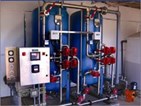AD26™ Systems from AdEdge Technologies Rapidly Gaining Popularity Among Small Water System Operators As Effective Solution For Co-occurrence Of Arsenic And Iron


Buford, GA - AdEdge Technologies, Inc. announces rapidly gaining popularity of AD26 technology among small water systems as an effective solution for co-occurrence of arsenic and iron. With more than 120 public water systems installed throughout North America and abroad, AdEdge and its proven AD26 technology has gained wide acceptance among system operators.
As many as 35-40% of the U.S. public water systems have arsenic levels above the MCL of 10 ppb, with the co-occurrence of iron above the secondary MCL of 0.3 mg/L. Historically the co-occurrence of arsenic and iron has presented a challenge for small systems which may or may not have any treatment in place for either iron or arsenic to meet their respective MCLs.
Designed by AdEdge specifically for well head treatment, AD26 systems feature a proprietary MnO2 media and are engineered as stand-alone systems for the removal of iron, manganese, sulfide, and arsenic if it coexists with high levels of iron.
“Until recently, such systems were only concerned with providing treatment or other means to achieve the secondary (non-enforceable) aesthetic aspects of having high iron or manganese in their water: red water staining, black deposits or other accumulation of precipitants in distribution and piping problems resulting in customer complaints. With the new MCL for arsenic in play, this has clearly changed,” said Greg Gilles, Vice President, AdEdge Technologies. “Our AD26TM is utilized in conventional pressure filtration vessels using chlorine to oxidize As (III) to As (V), enhance oxidation of naturally occurring iron (Fe+2 to Fe+3), providing optimal conditions for ferric arsenate complexes to form on the surface of the catalytically active media. Flow rates through the media bed(s) are three times that of conventional filtration with high efficiency removal, requiring smaller vessels and less space.”
SOURCE: ChartWater AdEdge
